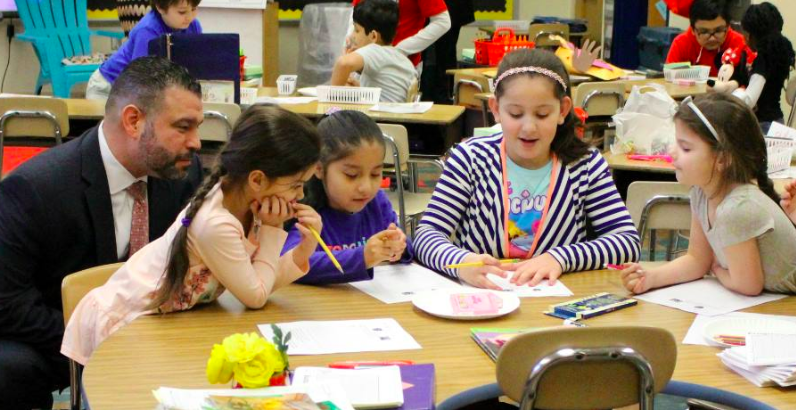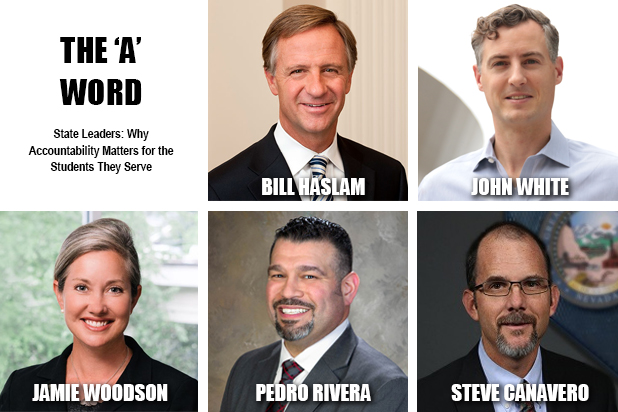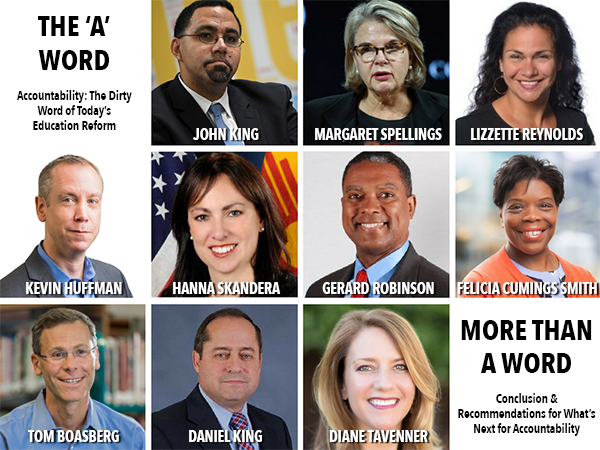Pedro Rivera: When Not Used the Right Way, Accountability Is Just Medicine That Is Masking the Root of the Problem — The ‘A’ Word

This interview is part of The ‘A’ Word series, produced in partnership with the Bush Institute to examine how “accountability” became a “dirty word,” and what can and should be done going forward to ensure accountability withstands the test of a bad reputation. The interviews were conducted over the telephone, transcribed, and edited for clarity and length. The same questions, or types of questions, were put to each participant to see what they thought independently and collectively about accountability. Their answers will take the reader into the inner workings of schools, the intricacies of the politics of education, and the ways in which campuses can better serve students. Click through the grid below to read other ‘A’ Word conversations from this part of the series. You can read through interviews from the first part of this series by jumping to the second grid here.
Pedro Rivera serves as Pennsylvania’s education secretary, a post he has held since June 2015. Before being selected by Democratic Governor Tom Wolf, Rivera led Lancaster, Pennsylvania’s school district for seven years. The district’s reforms during his tenure led to students showing greater proficiency in reading, writing, and math. His work prompted the White House in 2014 to name the former teacher, principal, and union executive a “Champion of Change” for his work in transforming urban education.
Rivera tells us that accountability sets standards and conditions for policymakers, educators, and communities. But he also likens it to a doctor’s diagnosis. It tells you the need, but adults must dig deeper into the conditions that created that need.
How do you define education accountability? And how has that definition changed over time?
Here in Pennsylvania we define accountability as being about a contract. We see it as an agreement among policy leaders, whether at the state or national level; educators; and the parents and families who entrust their kids to us. Accountability is the agreement that sets the standards and conditions by which policy leaders, educators, and the communities we serve come together and share expectations.
It is our job as policy leaders to establish the conditions and to ensure every student has access to resources so they can succeed, regardless of their gender, ethnicity, language, learning need, sexual orientation, or family income. It is up to stakeholders to speak up when what we expect from them and the supports being offered don’t line up. And it’s up to the parents, community members, and students to help inform the practice of accountability at the local level and the policy at the broader level.
This arrangement ultimately impacts the next generation workforce and our next leaders.
“Whenever you set a mandate and it doesn’t support teaching and learning, people don’t do it.”
And, yes, the definition has absolutely changed over time, especially as we learn more and are able to fit some context around accountability. Folks have tried to steer clear of an intentional conversation around accountability. In Pennsylvania, we’ve tackled that conversation.
We’ve done that by meeting with thousands of stakeholders across the Commonwealth. That includes educators, leaders, researchers, parents, student advocates, and lawmakers. There is now a common theme around what they want to see in their education system and accountability system.
Let me make a connection between a school system’s accountability system and going to your doctor. Let’s say you visit your doctor. He tells you that you have high blood pressure and gives you a pill to take. Nothing changes, but the doctor keeps giving you medications. He is only managing the situation without looking at the root cause of this diagnosis.
In that scenario, accountability is like the diagnosis. It tells you the need. But you need to dig deeper to better understand the conditions that created that need. We have to use the data that accountability systems produce to look more specifically at the root cause of the diagnosis. What is now needed in that education system?
When you tell a parent their child’s school is an A, B, C, or D school, or a focus school, or a priority school, without any explanation as to why or how they can improve, they’re not going to be interested in that accountability system. It is like your doctor giving you a diagnosis and not explaining what it means and how you can combat it.
You really have to focus on areas to improve and use strategies in digestible bites that allow schools to see progress and momentum. Folks start to rely on that kind of system, just like when your doctor focuses on your needs in a more holistic way.
We can look at education the same way. Look at equitable resources. Use diagnostics to look deeply into a problem. And provide opportunities for learners to meet their needs and to continuously improve. There isn’t a parent or leader that wouldn’t buy into that philosophy.
As a system, we need to be willing to make that kind of investment and explain why this strong, clear system of accountability is important.
(Click through the grid below to read other ‘A’ Word conversations)

You mentioned using data to drive improvement. How did you use data to drive change at the state level or while you were superintendent?
It’s important to give credit to Tom Wolf, our governor, and the team that we’ve pulled together. Governor Wolf allowed us to have a hard discussion. At first, it was to explain that our current system of accountability lacked credibility. It wasn’t equitable, and it heavily relied on standardized tests. We didn’t have multiple measures to address the needs of students.
We took two years to engage with stakeholders and get feedback. Scores on the state test used to count for most of a school or district rating, but now they count for about a third of the rating. We also have put a heavy reliance on growth to ensure students are growing year-to-year in the content of a subject.
And we have on-track measures. The research tells us that if we focus on specific factors, we can help ensure that students are going to graduate on time and are less likely to drop out. The factors we look at are third-grade reading-level attainment, seventh-grade math-level attainment, English acquisition for English learners, and meeting the needs of students with special needs and chronic absenteeism.
We also track college and career readiness. Our school districts submit to us a college and career readiness plan, which starts as early as elementary school. The plans seek to orient students around college and career options and engage kids in that conversation.
Part of this strategy was informed by my experience as a superintendent. I realized through surveys that parents of kids as early as third grade already started to believe that they couldn’t afford to send their kid to college. As local educators, we realized we had to change that perception and the information parents were getting.
We took that practice with us to the state level, where we engage first in elementary schools. Middle schoolers take a career inventory and then we support and identify college and career pathways at the high school level.
But we’re not stopping there. With the governor’s support, we’re also tracking data after high school graduation. And we’re working with agencies to track employment data, higher education data, and military data. This will allow us to start analyzing what kids are doing after they graduate from high school.
Now that you have finished your Every Student Succeeds Act plan, tell us how you engaged with stakeholders in its creation.
We’ve never stopped. When you engage with stakeholders and community members in an organic, authentic way, they never go away. When you don’t connect with them regularly, they’ll call you and ask, “When are we meeting again?”
We have continued to use our stakeholders and partners to inform all aspects of our education systems. We went from accountability and ESSA to school improvement, now from school improvement to STEM and computer science, and from STEM and computer science to workforce development equities. I can’t imagine us ever wanting to stop engaging our partners and stakeholders.
That said, when we started at the governor’s direction, I knew we had to engage stakeholders. Otherwise, we would just be creating policy that we thought would drive practice in the classroom. Having spent most of my career in a classroom, I knew that wouldn’t work. Whenever you set a mandate and it doesn’t support teaching and learning, people don’t do it.
We have engaged third parties to help facilitate engagement with stakeholders and parents and take notes. We set the agenda to make sure we were having a strategic conversation, but we let the facilitators guide the conversation. Today, I can say, “We’ve met with well over 3,000 stakeholders across the Commonwealth. We tried to meet with every different kind of demographic, and we didn’t always hear what we thought we’d hear.” They challenged us, which was healthy.
“There were many times where I felt like something was being done to me, especially in terms of accountability. If we can change that mindset for educators, students, parents, and community members … so they know we want to work with them on equity and continuous improvement, we will continue improving our schools.”
We have a number of new governors across the country. What advice would you have for them and their education advisers as they grapple with these issues?
First, it is possible to work on education in a bipartisan manner. Our governor is a Democrat. The General Assembly is overwhelmingly Republican. Many members are rural and very conservative. Working together and being open and honest and engaging in good, rich, deep dialogue, we were able to accomplish five significant parts of our agenda.
We adopted a basic education funding formula that was heavily focused on equity. We were able to pass our ESSA plan along with a strong accountability system. We strategically reduced the number of days students are administered state standardized tests, and we’re testing later in the school year to allow for more instructional time. We were able to pass new graduation standards that identify college and career readiness as well as the traditional standardized test pathway. We were able to pass an aggressive school safety bill that focuses on the social and emotional needs of kids. And we provided money and grants for everything from mental health services to safety and security and infrastructure.
Those examples show bipartisan work is possible.
(Click through the grid below to read the ‘A’ Word conversations from the first part of this series)

Tell us about the continuous improvement process you all have around your ESSA plan. What does that look like in Pennsylvania?
We ran a pilot first. We identified three school districts – one rural, one suburban, and one urban – to work with us to inform our practice. We engaged their leaders to help us create a plan that would focus our school improvement efforts on their individual needs, looking at everything from their performance status to their demographics. We developed a draft plan to build upon the strengths and needs of those kids and educators.
There have been “aha” moments working through the pilot. We started with classroom instruction, but we realized we had to take a step back and look at district leadership. District leaders ensure continuity and a focus on the district’s goals and support systems.
We also recognized that school leadership is extremely important and that the voices of teachers ensure a focus on the applicable practice of our strategies. By engaging all stakeholders, you can build a plan to move forward.
We are now also creating a clearinghouse of practices for schools to use as a resource. That allows us to help all the kids across the Commonwealth.
What holy grail issues have we been unwilling to address in education?
There is the “E” word for equity. You cannot be true to a focus on accountability and continuous improvement without providing an equitable distribution of resources. We know this nationally. And we know this historically. Some of the neediest communities also happen to be some of the lowest-performing districts and least-resourced districts.
Equity doesn’t mean taking resources away from one school and community to give to another school and community. Equity means identifying what works in some of the high-performing communities and providing those opportunities and resources to every community in a manner they need and at a time they need them.
Equity is about providing the same resources and opportunities to all students regardless of zip code.
What is at stake for us as a country to get these issues right? What’s at stake for Pennsylvania?
I’ve only been in government for four years. I’ve been a practitioner my whole career. There were many times where I felt like something was being done to me, especially in terms of accountability. If we can change that mindset for educators, students, parents, and community members alike, and change the narrative so they know we want to work with them on equity and continuous improvement, we will continue improving our schools.
Going back to the doctor analogy, the medicine the doctor gives you doesn’t do away with your high blood pressure. It just masks that something needs to be addressed. The same is true when you are not using your accountability structure in the right way. You’re not getting people to look at the root cause of a problem.
Anne Wicks is director of education reform at the George W. Bush Institute. William McKenzie is editorial director at the George W. Bush Institute.
Get stories like these delivered straight to your inbox. Sign up for The 74 Newsletter

;)